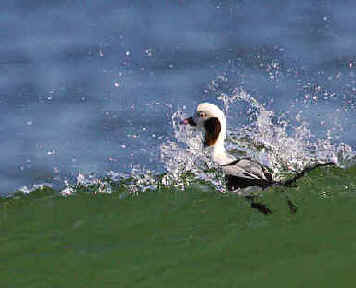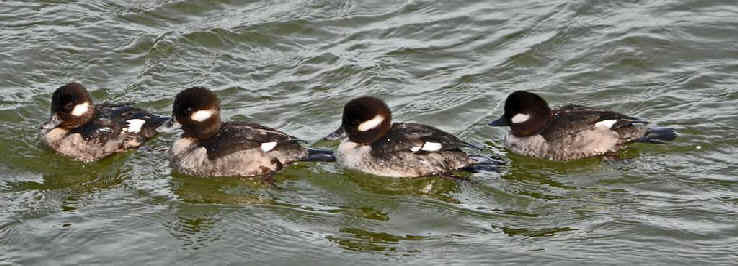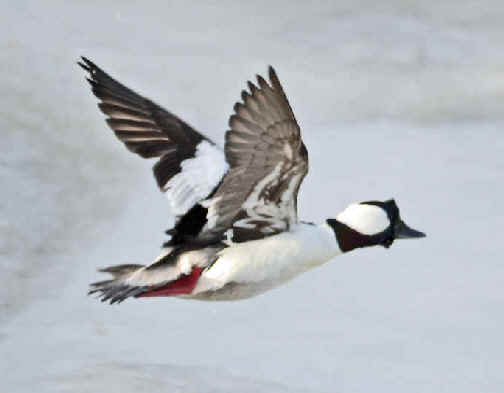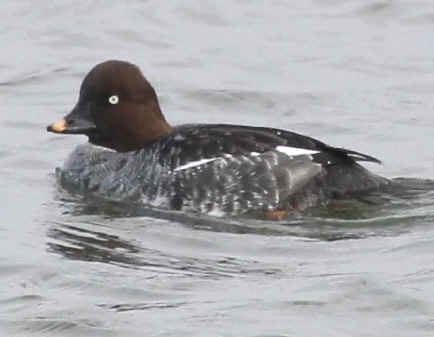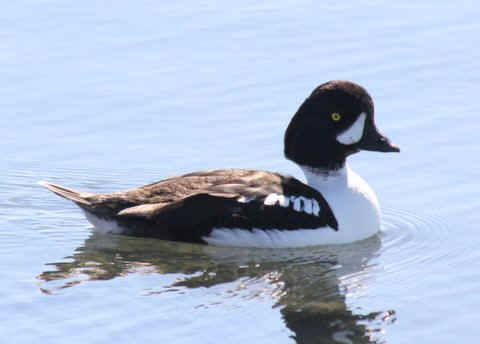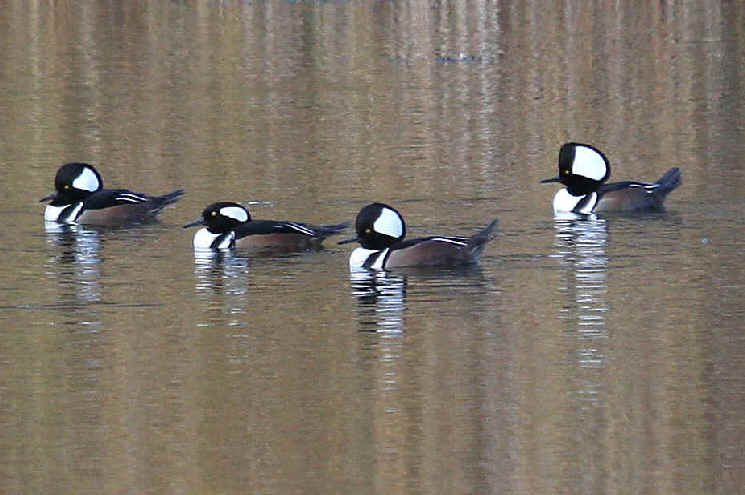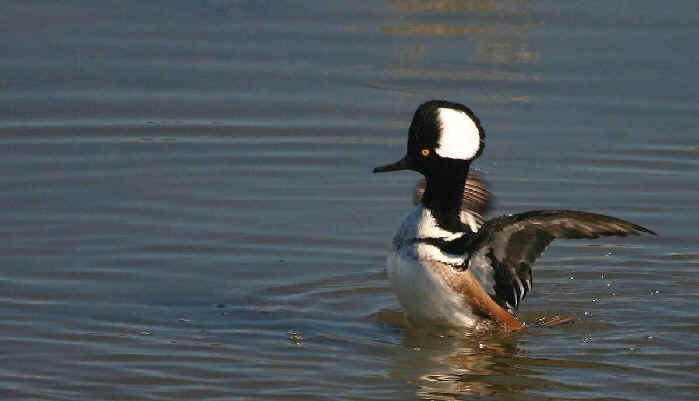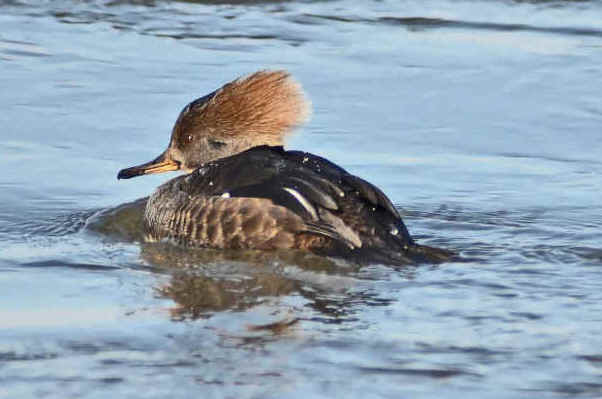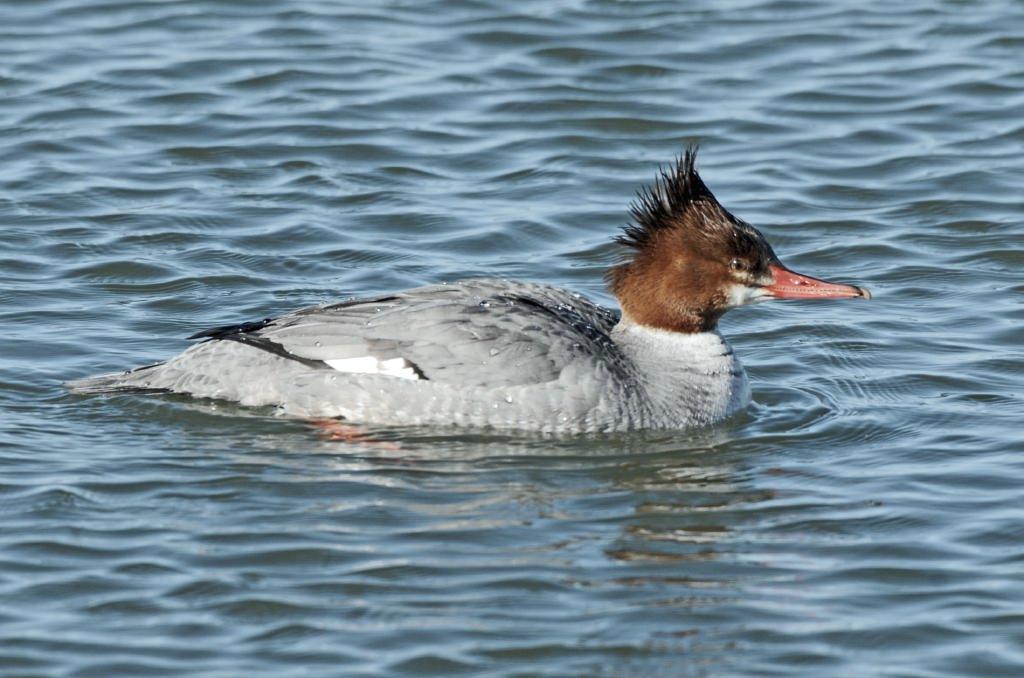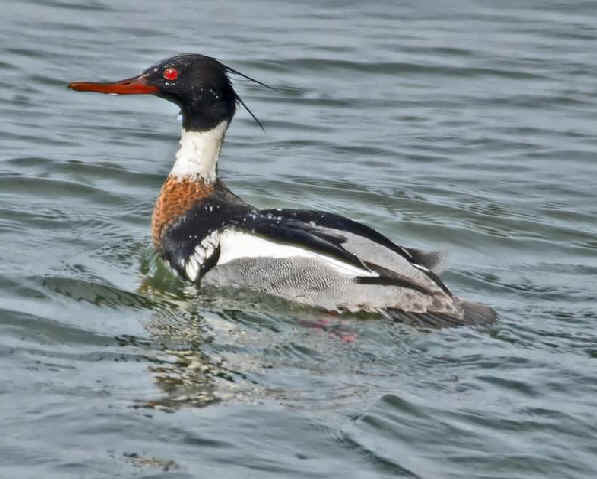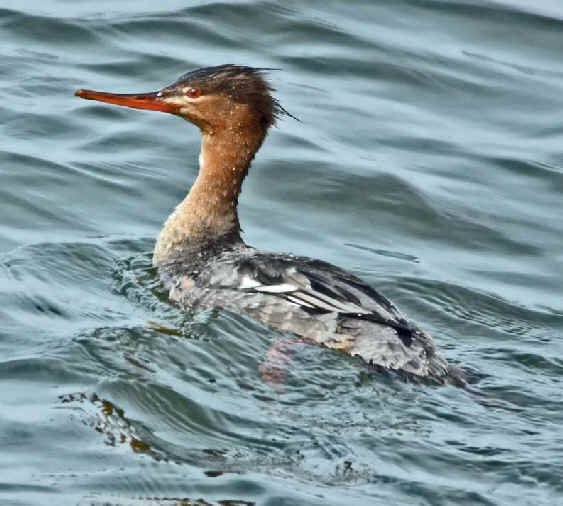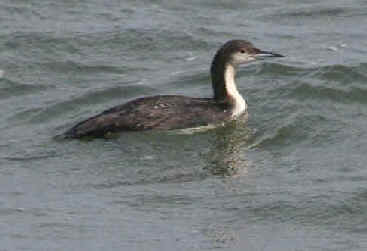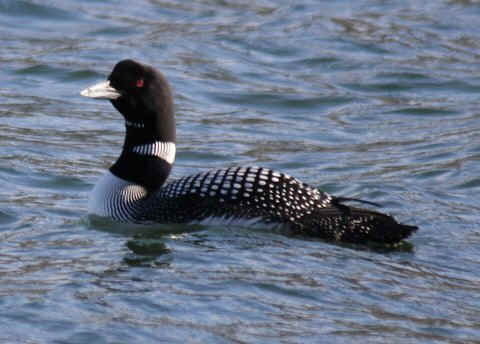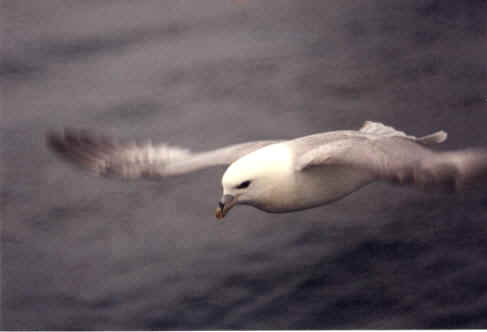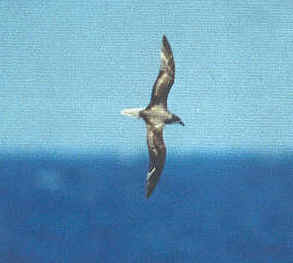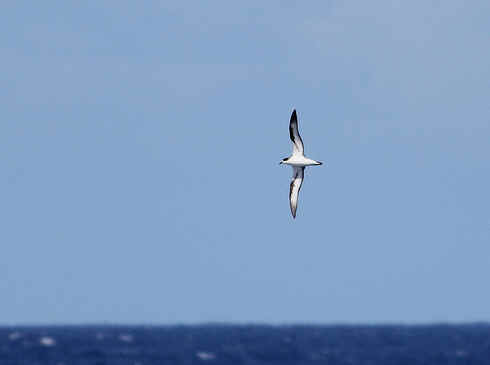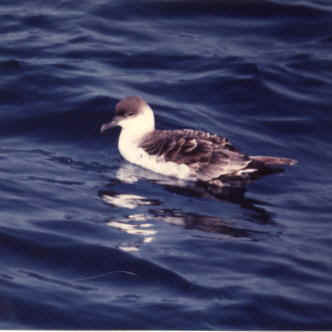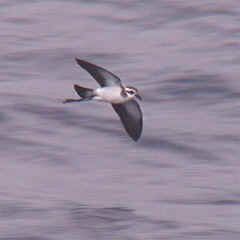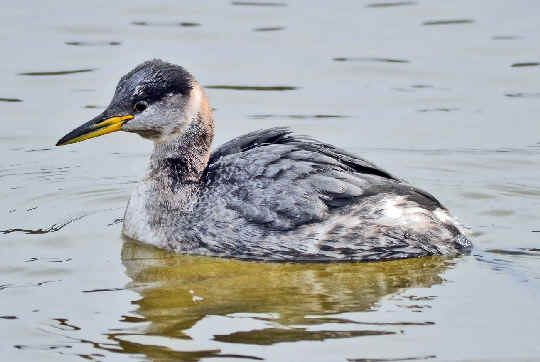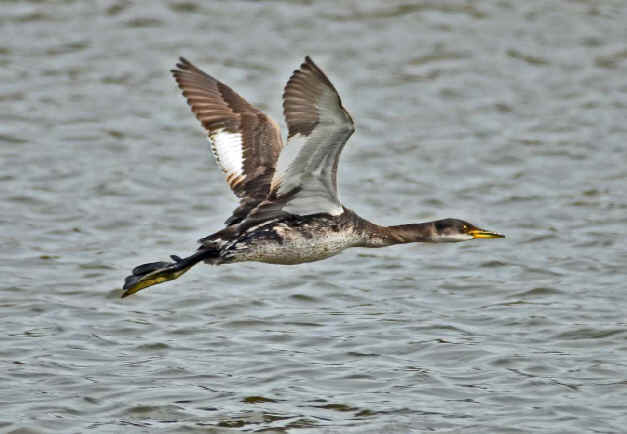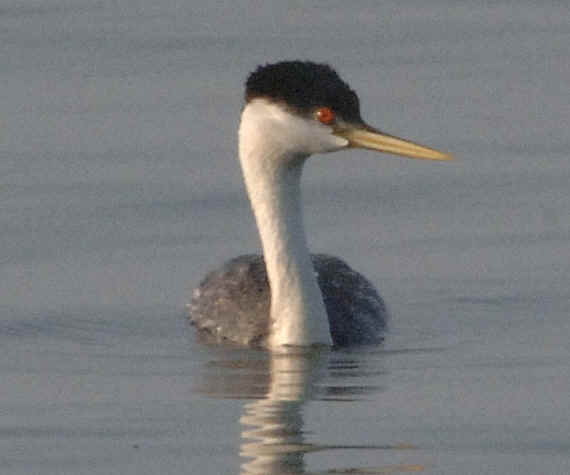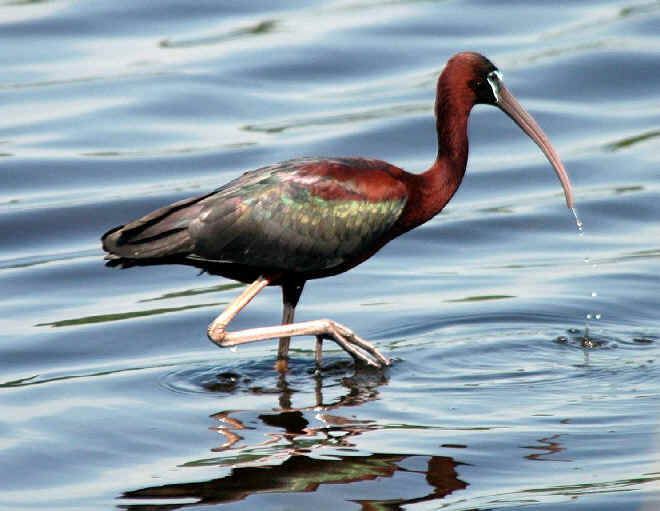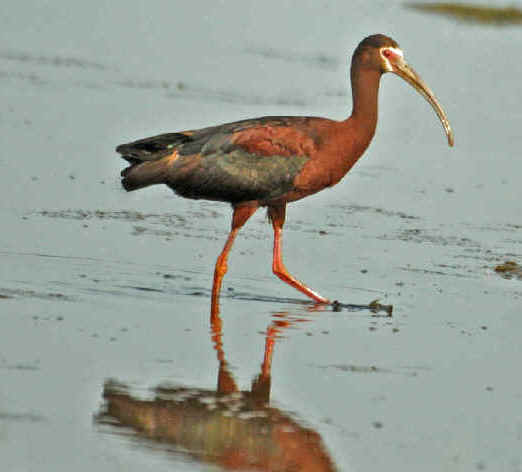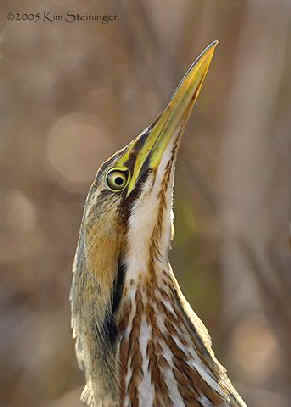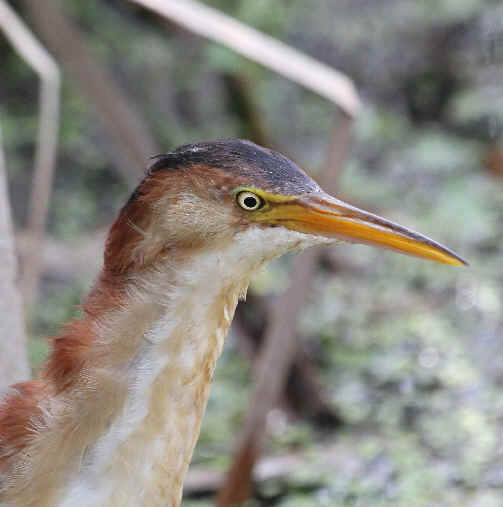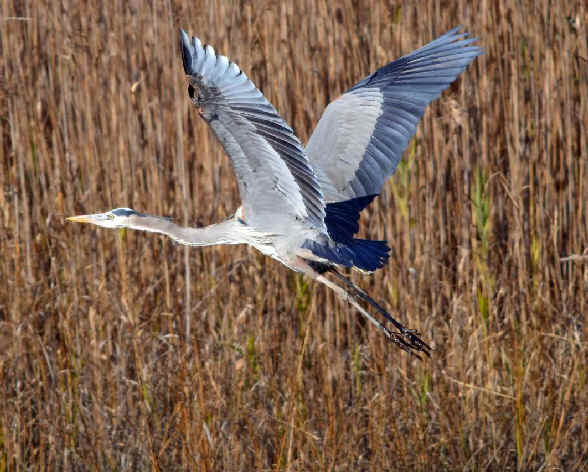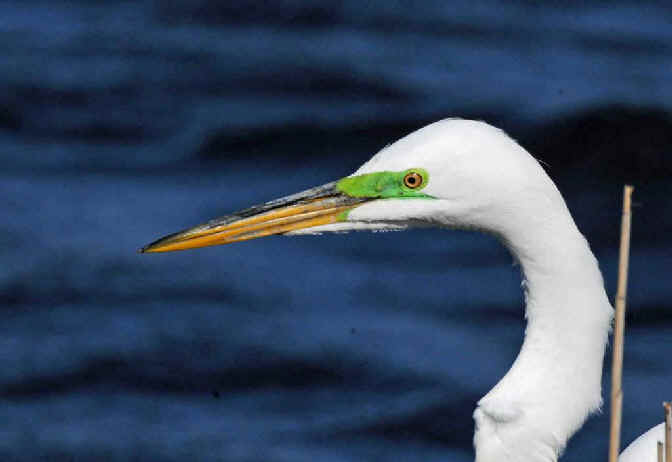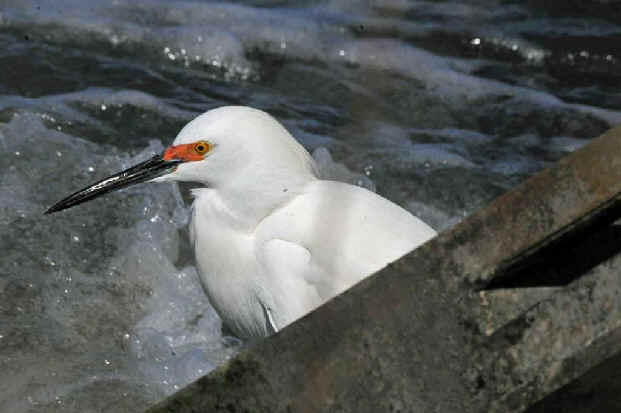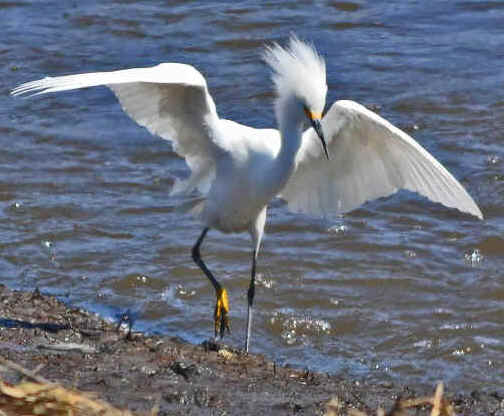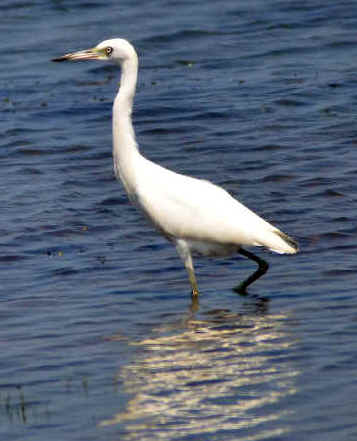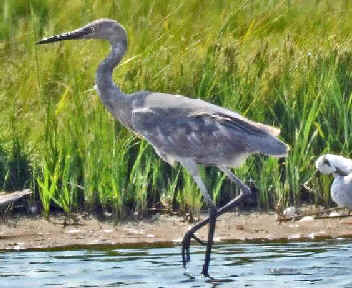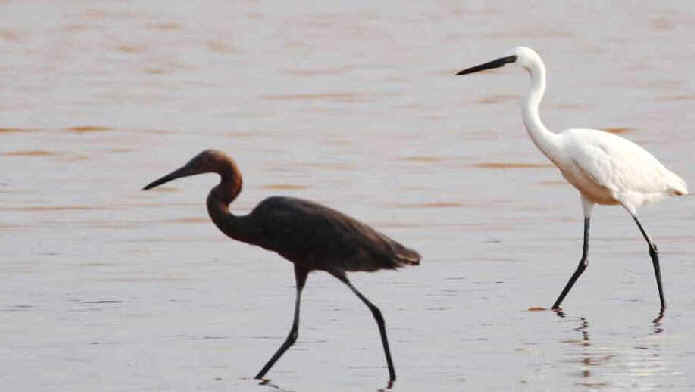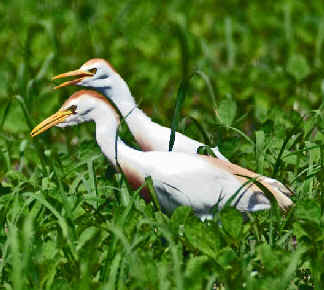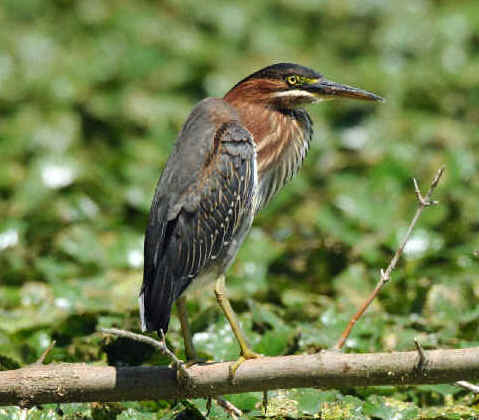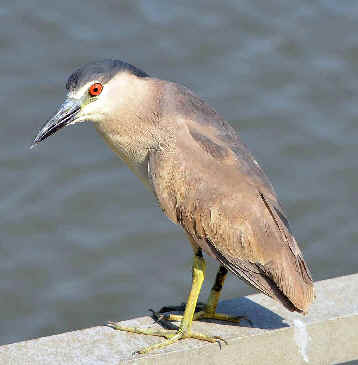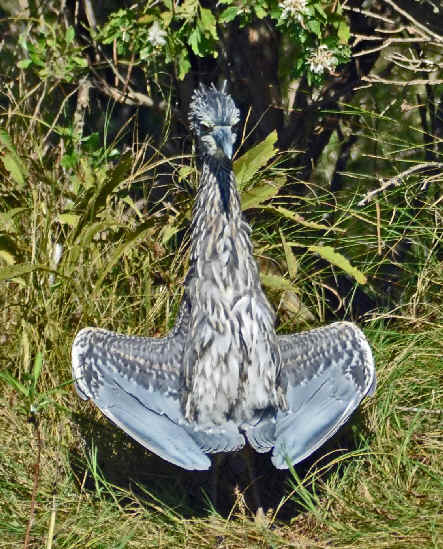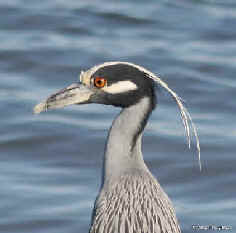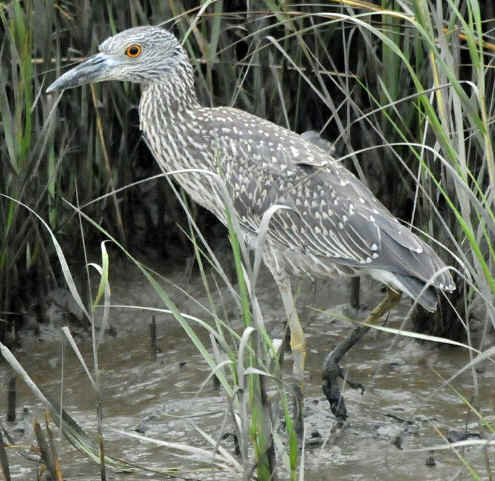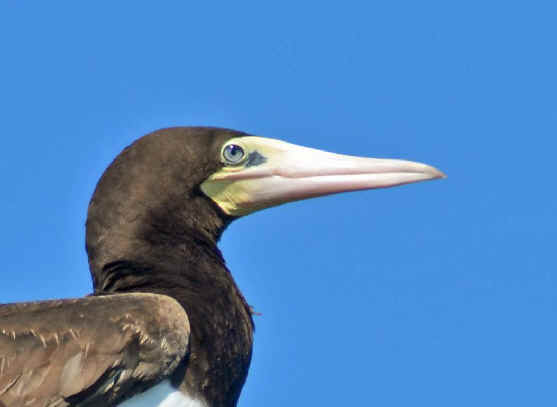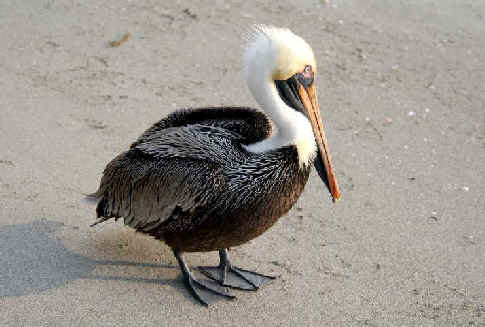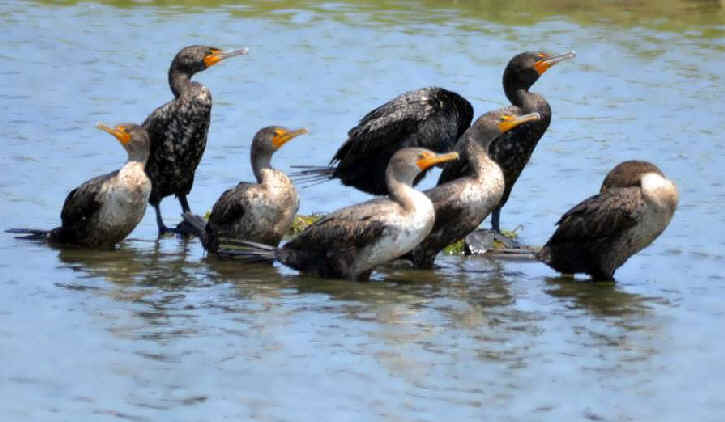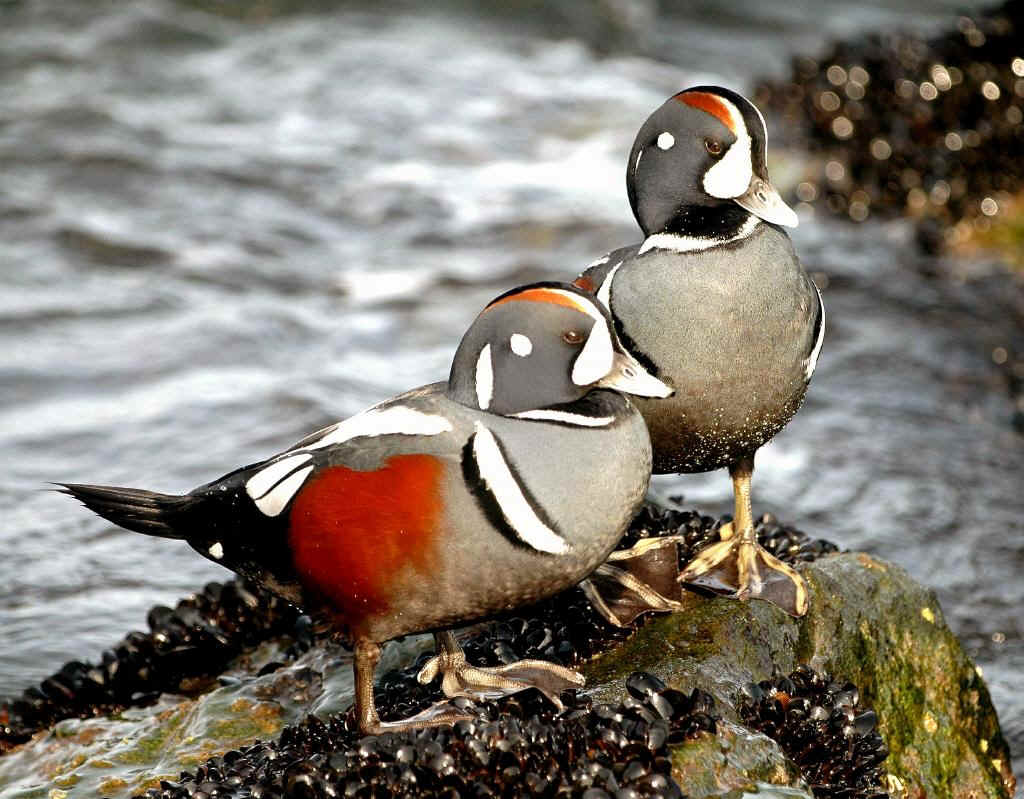
The
Birds
of
North America
From Grouse to Anhinga
Part 1 of a List
and Photo Gallery
of North American Birds
compiled by Armas Hill
Noting birds found during Focus On Nature Tours in Alaska, Arizona,
British Columbia, California, Colorado, Delaware, Florida, Iowa, Kansas, North
Carolina, Nebraska, Newfoundland, New Jersey, New Mexico, Oklahoma, Texas,
Virginia, Washington State, & Wyoming, including offshore pelagic trips
Birds found during FONT tours & pelagic trips in North America, north
of the Rio Grande, have an (*).
PHOTO AT UPPER RIGHT: drake HARLEQUINS
(photo by Howard Eskin)
CODES:
In the list that follows, birds found during FONT tours are noted, indicating
the US state or Canadian
province & the months when found.
(The codes below relate to the United States unless indicated otherwise.)
AK: Alaska
AZ: Arizona
BC: British Columbia, Canada (until 2001, during our West Coast Tours
in September)
CA: California
(during our September West Coast Tours)
CO: Colorado
DE: Delaware (including offshore pelagic trips from DE
and Delmarva land-birding and nature tours)
FL: Florida
IA: Iowa
(with our Nebraska Tours in March)
KS: Kansas (with our Colorado Tours in April)
MD: Maryland
(Delmarva tours)
NC: North Carolina (including offshore pelagic trips and
spring and summer land-birding tours)
NE: Nebraska (tours in March & with our Colorado
tours in April)
NF: Newfoundland, Canada
NM: New Mexico (with our West Texas Tours in the spring
and our Arizona Tours in the late-summer)
OK: Oklahoma (with our Colorado Tours in April)
TX: Texas
VA: Virginia (Delmarva
tours and in conjunction with the NC Tour in the
spring)
WA: Washington State (during our September West Coast
Tours)
WY: Wyoming (with our Colorado Tours in April)
During FONT pelagic trips:
DEP: offshore from Delaware
CAP: offshore from California
NCP: offshore from North Carolina
NJP: offshore from New Jersey
WAP: offshore from Washington State
The months when the birds have been found are with the above codes.
(ac): north of the Arctic Circle
(DT): in the area of the Dry Tortugas
islands in Florida
(PI): at the Pribilof Islands in
Alaska
(USe):
endemic
to the USA
(USqe): quasi (or nearly) endemic to the USA
(USeb): endemic-breeder in USA
(USneb): near-endemic breeder in the USA
(NAi): species introduced into North America
(NAri): re-introduced species
(r/NA): rare in North
America
(r/US): rare in the USA
(t): a globally threatened or rare species, designated by Birdlife International
(t1): critical (t2): endangered (t3): vulnerable
(nt): a near-threatened species globally
(ph): species with a photo in the FONT web-site
Links to Bird Groupings in this
part of this List:
Gallinaceous Birds Waterfowl
Loons Pelagic Birds
Grebes
Flamingo, Storks Ibises, Spoonbill
Bitterns,
Herons, Egrets
Tropicbirds, Frigatebirds Boobies, Gannet
Pelicans, Cormorants, Anhinga
Links to Other Parts of this
North American Bird List:
Part #2: Condor to Shorebirds
Part
#3: Jaegers to Cuckoos
Part #4: Owls to Flycatchers
Part
#5: Shrikes to Pipits Part #6: Olive Warbler to Buntings
Links to
Lists of Birds of:
Alaska
Arizona California
Colorado Delaware,
Maryland, Virginia (Delmarva Peninsula)
North
Carolina Texas
Washington State
Links to
Lists & Photo Galleries of Other Nature, including North
American:
Mammals
Butterflies, Dragonflies
Amphibians,
Reptiles Marine Life, inc Fish,
Crustaceans
Links to
Information about Upcoming FONT Birding & Nature Tours:
in North America by month in:
2015 2016
or:
by geographic location worldwide
Other Links:
Directory
of Photos in this Website
A Photo Gallery of Birds that
would be Rare In North America

List of Birds:
GALLINACEOUS
BIRDS
- Plain Chachalaca (*) (ph) ______ TX:may
Ortalis vetula
SUBSPECIES NORTH OF MEXICO:
Ortalis vetula mccallii ______ subspecies in
south Texas, and in Mexico south to Vera Cruz
South of the US, the Plain Chachalaca has been seen during
FONT tours in Belize, Guatemala, Honduras, Mexico.
- Chukar Partridge (NAi) (*) ______ CO:apr
WA:sep
Alectoris chukar
Outside North America, the Chukar Partridge has been seen
during FONT tours, where it is native, in Bulgaria, Turkey.
- Gray Partridge (NAi) (*) ______ WA:sep
Perdix perdox
Outside North America, where "gray" is spelled "grey",
the Grey Partridge has been seen during FONT tours, where it is
native, in Bulgaria, Hungary, Poland, Spain, Sweden.
(Another name for the species is "Hungarian Partridge".)
- Himalayan Snowcock (NAi) ______
Tetraogallus himalayensis
- Common Pheasant (NAi) (*) ______
BC:sep CA:sep CO:apr,jul DE:apr,may KS:apr
NC:jun NE:mar,apr NM:apr OK:apr
WA:sep
Phasianus colchicus
Outside North America, the Common Pheasant has been seen
during FONT tours in Bulgaria, Hungary, Poland, Romania, Slovakia,
Spain, Sweden.
Some Common Pheasants, dependent upon their race, have
also been called "Ring-necked Pheasant".
- Greater Prairie
Chicken (t3) (*) (ph) ______ CO:apr NE:mar,apr
Tympanuchus cupido
SUBSPECIES:
Tympanuchus cupido attwateri Attwater's Prairie
Chicken ______ now very
rare, this subspecies along the Gulf Coast of Texas, and formerly in
Louisiana
Tympanuchus cupido cupido Heath Hen
______ now extinct, this subspecies was in the
northeastern United States
Tympanuchus cupido pinnatus ______ subspecies
from south-central Canada to northeast Texas
Tympanuchus cupido was described by Linnaeus in 1758.
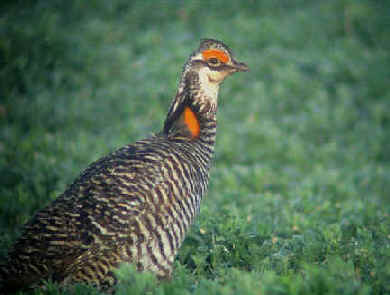
A Greater Prairie Chicken photographed during a
FONT tour
(photo by Rick Greenspun)
- Lesser Prairie Chicken (t3) (USe) (*) (ph)
______ CO:apr KS:apr
Tympanuchus pallidicinctus (monotypic)
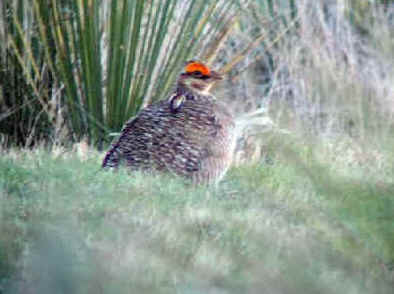
A Lesser Prairie Chicken photographed during a
FONT tour
(photo by Rick Greenspun)
- Sharp-tailed Grouse (*) ______ CO:apr
NE:mar,apr
Tympanuchus phasianellus
SUBSPECIES:
Tympanuchus phasianellus campestris
______ subspecies from central Canada to Wisconsin
Tympanuchus phasianellus caurus ______ subspecies
from Alaska to northern British Colombia and northern Alberta
(subspecies described in 1943)
Tympanuchus phasianellus columbianus ______
subspecies from British Colombia to western Colorado
Tympanuchus phasianellus jamesi ______
subspecies from Alberta to Wyoming and Nebraska
Tympanuchus phasianellus kennicottii ______ subspecies
in Mackenzie
Tympanuchus phasianellus phasianellus ______ subspecies
from Manitoba to Quebec
Tympanuchus phasianellus
was described by Linnaeus in 1758.
- Dusky Grouse (*) (ph) ______ CO:apr
Dendragapus obscurus
When the Dusky Grouse and the Sooty Grouse
(below) were combined, the species was the "Blue Grouse".
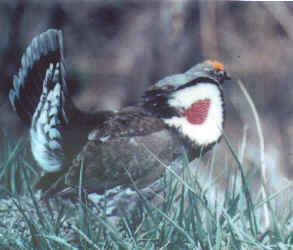
A Dusky Grouse photographed during a FONT tour
(photo by Alan Brady)
- Sooty Grouse (*) ______ WA:sep
Dendragapus fuliginosus
In Washington State, both Sooty and Dusky Grouse occur. The Sooty is in
western Washington and on the east slope of the Cascades in the central part
of the state. The Dusky is further east in Washington.
- Greater Sage Grouse (nt) (*) (ph) ______ CO:apr,jul
Centrocercus urophasianus
(monotypic)

Greater Sage Grouse photographed in Colorado in April 2010
- Gunnison Sage Grouse (t2) (USe) (*) ______ CO:apr
Centrocercus minimus (monotypic)
In 2001, the Gunnison Sage Grouse was described as a
full species, with its distribution restricted to about 8.5% of its historic
range in Colorado and adjacent Utah. Nearly the entire population now is in
south-central Colorado.
- Ruffed Grouse (*) (ph) ______
WA:sep
Bonasa umbellus
SUBSPECIES:
Bonasa umbellus affinis ______ subspecies
from British Columbia, Canada to Oregon, US
Bonasa umbellus brunnescens ______ subspecies in
Vancouver Island, British Columbia, Canada
Bonasa umbellus castanea ______ subspecies in
Washington State in the Olympic Mountains, described
in 1943
Bonasa umbellus incana ______ subspecies in Utah,
described in 1943
Bonasa umbellus labradorensis ______ subspecies
in Labrador, Canada, described in 1990
Bonasa umbellus mediana ______ subspecies in
Minnesota, described in 1940
Bonasa umbellus monticola ______ subspecies in
West Virginia, described in 1940
Bonasa umbellus obscura ______ subspecies in
northern Ontario, described in 1947
Bonasa umbellus phaia ______ subspecies in
Idaho, described in 1943
Bonasa umbellus sabini ______ subspecies along
the Pacific coast from British Columbia, Canada to California, US
Bonasa umbellus togata ______ subspecies in the
northeast and north-central US and in Nova Scotia, described by Linnaeus in
1766
Bonasa umbellus umbelloides ______ subspecies
from southern British Colombia to Manitoba and northern Colorado
Bonasa umbellus umbellus ______ subspecies in the east-central
US
Bonasa umbellus yukonensis ______ subspecies in
Northwest Canada and Alaska
Bonasa umbellus
was described by Linnaeus in 1766.
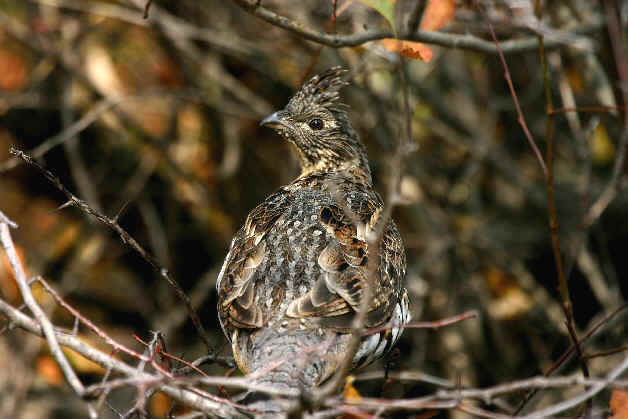
Ruffed Grouse. This bird in western North America.
(photo by Ed Kendell)
- Spruce Grouse ______
Falcipennis canadensis
SUBSPECIES:
Falcipennis canadensis atratus ______ subspecies
in southern Alaska
Falcipennis canadensis canace ______ subspecies
in southeastern Canada and the north and northeastern US, subspecies described by Linnaeus in
1766
Falcipennis canadensis canadensis ______
subspecies from Alberta to Labrador and Nova Scotia
Falcipennis canadensis franklinii ______
subspecies from southeastern Alaska to northern Wyoming
Falcipennis canadensis isleibei ______
subspecies in southeastern Alaska, described in 1996
Falcipennis canadensis
was described by Linnaeus in 1758.
- White-tailed Ptarmigan (*) (ph)
______ CO:apr
Lagopus leucurus
SUBSPECIES:
Lagopus leucurus altipetens ______ subspecies
in the Rocky Mountains fro Montana to New Mexico
Lagopus leucurus leucurus ______ subspecies in
northern British Colombia
Lagopus leucurus peninsularis ______ subspecies
in central Alaska and the Yukon
Lagopus leucurus rainierensis ______ subspecies
in central and southern Washington State including Mt. Rainier
Lagopus leucurus saxatilis ______ subspecies on
Vancouver Island
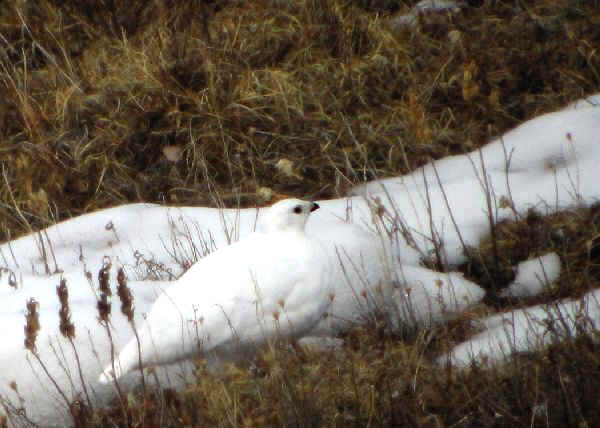
A White-tailed Ptarmigan photographed in Colorado in April 2010
- Willow Ptarmigan (*) ______
AK:may,jun
Lagopus lagopus
SUBSPECIES IN NORTH AMERICA:
Lagopus lagopus alascensis ______ subspecies
in most of Alaska
Lagopus lagopus alba ______ subspecies in
mainland northern Canada, except the northeast
Lagopus lagopus alleni ______ subspecies in
Newfoundland
Lagopus lagopus alexandrae ______ subspecies in
southern and southeastern Alaskan islands, and northwestern British Colombia
Lagopus lagopus leucoptera ______ subspecies on
northern Canadian islands
Lagopus lagopus muriei ______ subspecies on the
Aleutian & Kodak islands in Alaska
Lagopus lagopus ungavus ______ subspecies in
northern Canada, east of the Hudson Bay
- Rock Ptarmigan (*) (ph) ______
AK:may,jun
Lagopus muta
Outside North America, the Rock Ptarmigan has been seen during
FONT tours in Iceland.
Worldwide, there are 24 subspecies.

Above: a drawing of Rock Ptarmigans by Charles Gambill
Below: a photo by Alan Brady of a Rock Ptarmigan during a FONT tour
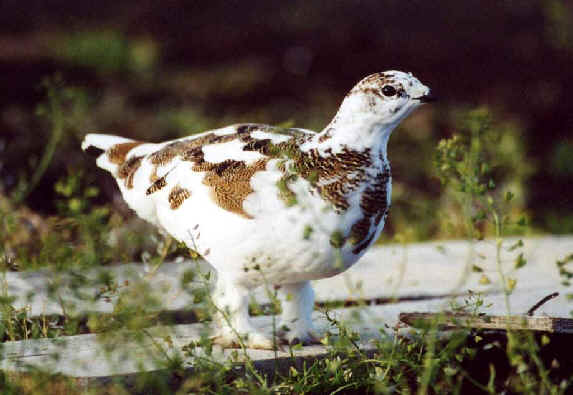
- Wild Turkey (*) (ph) ______ AK:may
AZ:jul CA:sep
CO:apr DE:apr,may KS:apr MD:apr NC:jun NE:mar,apr NM:apr
OK:apr TX:mar,apr,may
Meleagris gallopavo
Some populations of the Wild Turkey have either been introduced, or
re-introduced.
SUBSPECIES NORTH OF MEXICO, with original ranges:
Meleagris gallopavo intermedia ______ subspecies
from northern Texas to northeastern Mexico
Meleagris gallopavo merriami ______ subspecies
in the southwestern US and northwestern Mexico
Meleagris gallopavo osceola ______ subspecies in
southern Florida
Meleagris gallopavo silvestris ______ subspecies
in the southeastern US
Meleagris gallopavo
was described by Linnaeus in 1758, a subspecies in central
Mexico.
South of the US, a notable subspecies. the "Gould's Wild
Turkey", M. g. mexicana, has been seen during FONT
tours in Mexico
(Sonora)
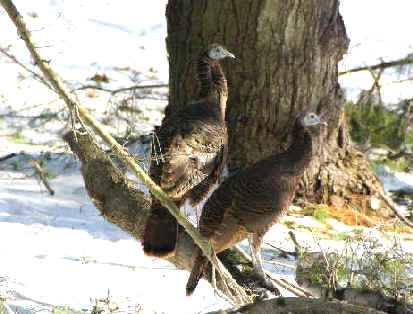
Wild Turkeys
(photo courtesy of James Scheib)
- Scaled Quail (*) ______ AZ:jul,aug,sep
CO:apr
NM:apr,jul OK:apr TX:apr,may
Callipepla squamata
SUBSPECIES NORTH OF MEXICO:
Callipepla squamata castanaogastris ______ subspecies
in southern Texas and northeastern Mexico
Callipepla squamata hargravei ______ subspecies
in New Mexico, described in 1973
Callipepla squamata pallida ______ subspecies in
the southwestern US and northwestern Mexico
- Gambel's Quail (*) (ph) ______ AZ:jan,jul,aug,sep
TX:apr,may
Callipepla gambelii
SUBSPECIES NORTH OF MEXICO:
Callipepla gambelii gambelii ______ subspecies
in the southwestern US and northwestern Mexico
South of the US, the Gambel's Quail has been seen during
FONT tours in Mexico (Sonora).
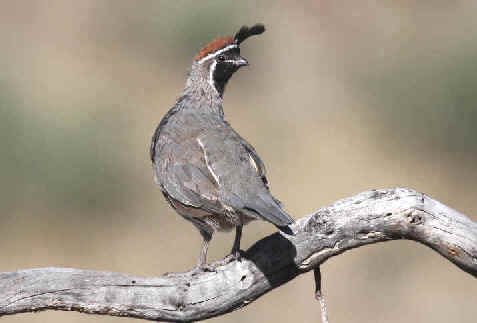
A Gambel's Quail
photographed during a FONT tour in Arizona
(photo by Marie Gardner)
- California Quail (*) ______ CA:sep
WA:sep
Callipepla californica
SUBSPECIES NORTH OF MEXICO:
Callipepla californica brunnescens ______
subspecies along the Pacific coast from southwestern Oregon to central
California
Callipepla californica californica ______
subspecies from eastern Oregon to northwestern Mexico
Callipepla californica canfieldae ______
subspecies in east-central California
Callipepla californica catalinensis ______ subspecies
on Santa Catalina Island
South of the US, the California Quail has been seen during FONT
tours in Chile, where it was introduced. It is said that the
population of
California Quails in Chile is now greater than in North
America.
- Mountain Quail (*) ______ CA:sep
Oreotyx pictus (the single member of its genus)
SUBSPECIES NORTH OF MEXICO:
Oreotyx pictus eremophilus ______ subspecies in
southern California
Oreotyx pictus pictus ______ subspecies from
southwestern Washington State to northern California, west of the Cascade
Mountains
Oreotyx pictus plumifer ______ subspecies in
Oregon, northeastern California, and Nevada, east of the Cascade Mountains
Oreotyx pictus russell ______ subspecies in California
in the Little San Bernardino Mountains, described in 1946
- Northern Bobwhite (nt) (*) (ph) ______ CO:apr
DE:may KS:apr NC:may,jun,aug TX:mar,apr,may
Colinus virginianus
SUBSPECIES NORTH OF MEXICO:
Colinus virginianus floridanus ______ subspecies
in Florida and the Bahamas
Colinus virginianus ridgwayi ______ subspecies
historically in southern Arizona (SEE BELOW)
Colinus virginianus taylori ______ subspecies
from South Dakota to northern Texas
Colinus virginianus virginianus ______
subspecies in the eastern and central US
Colinus virginianus
was described by Linnaeus in 1758.
South of the US, the Northern Bobwhite has been seen
during FONT tours in Mexico.
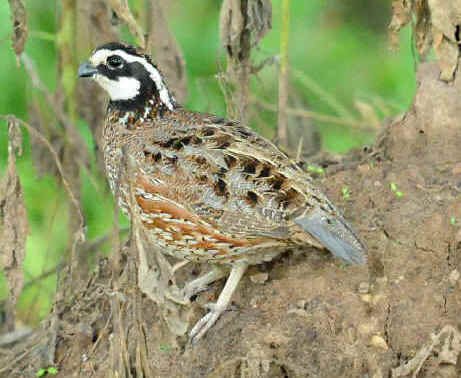
Northern Bobwhite
(photo by Howard Eskin)
"Masked" Northern Bobwhite (*) (ph) ______ (r/US) AZ:jul,aug
Colinus virginianus ridgwayi
Historically, this distinctive subspecies was found in southern Arizona
in the US & in Sonora, Mexico. It disappeared from the US portion of
its range in the early 1900s. A reintroduction into Arizona was done
in the 1970s, and now it is rare both there and in Mexico.
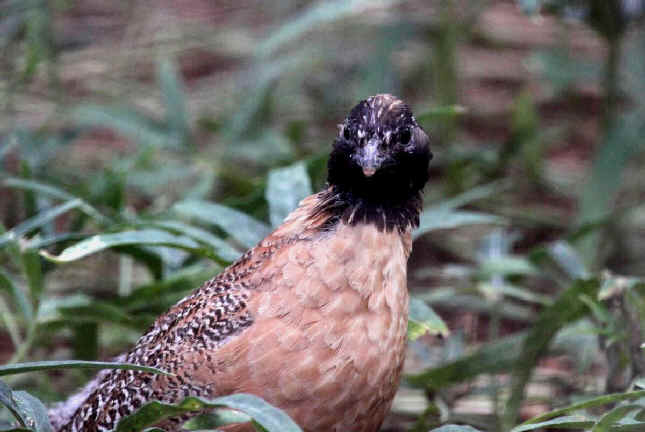
Masked Bobwhites photographed during a FONT tour in
Arizona
Above: male. Below: female
(photos by Marie Gardner)

- Montezuma Quail (*) ______ AZ:jul,aug
TX:apr
(former names have been Harlequin Quail &
Mearn's Quail)
Cyrtonyx montezumae
SUBSPECIES NORTH OF MEXICO:
Cyrtonyx montezumae mearnsi ______ (subspecies in
the southwestern US & northwestern Mexico)
South of the US, the Montezuma Quail has been found during
FONT tours in Mexico (Sonora).
WATERFOWL
- Black-bellied Whistling Duck (*) (ph) ______ AZ:jul
TX:apr,may
Dendrocygna autumnalis
SUBSPECIES NORTH OF MEXICO:
Dendrocygna autumnalis autumnalis ______
(subspecies from the United States to Panama)
Dendrocygna autumnalis
was described by Linnaeus in 1758.
During the summer of 2010, and others since, there have been influxes of Black-bellied
Whistling Ducks in the northeast US, with about 2 dozen birds at various
places in Pennsylvania alone, and others in Delaware, Maine, Maryland, New Jersey, New
York, and Virginia.
South of the US, the Black-bellied Whistling Duck has been seen
during FONT tours in Argentina, Belize, Brazil, Costa Rica, Ecuador, Guatemala, Honduras,
Mexico, Panama, Venezuela.
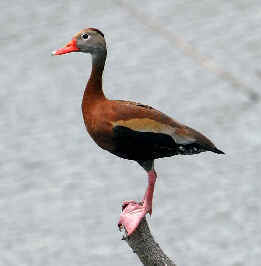
Black-bellied Whistling Duck
(photo by Howard Eskin)
- Fulvous Whistling Duck ______
Dendrocygna bicolor (monotypic)
South of the US, the Fulvous Whistling Duck has been seen during
FONT tours in Argentina, Belize, Brazil, Costa Rica, Venezuela.
- Greater White-fronted Goose (*) ______ AK:may,jun
(PI) CA:sep
CO:apr IA:mar NE:mar WA:sep
Anser albifrons
In 1994, there were said to be 2 subspecies of the Greater
White-fronted Goose. In 2008, there were said to be four.
In 2011, it was said that with the 5 well-defined "population
units" occurring in North America, they may involve 4
subspecies on the continent, as
noted below, or one more.
SUBSPECIES IN NORTH AMERICA
(from west to east):
"Pacific White-fronted Goose" Answer
albifrons sponsa ______ subspecies breeds in
western Alaska, winters from California to western Mexico
"Tule White-fronted Goose" Anser albifrons elgasi ______
subspecies with a small population that breeds in central Alaska, winters to
central California
"Tundra White-fronted Goose"
Anser albifrons gambeli (and
possibly
A. a, frontalis) ______ subspecies that breeds
in the Arctic, in Canada and Alaska, including 2 "units". one on
the tundra, and one on the taiga. winters in the south-central US and
northern Mexico
"Greenland White-fronted Goose" Anser
albifrons flavirostris ______ subspecies that
breeds in Greenland, wintering mostly in Britain and Iceland, but with some
in eastern North Amercia,
a different subspecies than that on mainland Eurasia (Anser
albifrons albifrons) which has not been known to occur in
North America
Outside North America, the Greater White-fronted Goose has been seen
during FONT tours in Bulgaria, Hungary, Iceland, Japan, Poland,
Sweden.
- Taiga Bean Goose ______
(r/NA)
Anser fabalis
- Tundra Bean Goose (*) ______
(r/NA) AK:may (PI)
Anser serrirostris
Recently split, both of the Bean Geese are Eurasian species. The
former Bean Goose has occured rarely in Alaska, on the Aleutian Islands and
other islands in the Bering Sea, mostly in the spring. There have been
scattered occurrences elsewhere in North America.
Outside North America, the Bean Geese (Taiga & Tundra) have been seen during FONT tours
in Japan, Poland, Sweden.
- Pink-footed Goose (ph) ______ (r/NA)
Anser brachyrhynchus (monotypic)
A species that breeds in eastern Greenland & in the highlands of
Iceland, and normally winters in western Europe. It has occurred rarely in
eastern North America, in places such as Newfoundland, Canada and
Pennsylvania in the US.
Outside North America, the Pink-footed Goose has been seen during
FONT tours in Iceland.
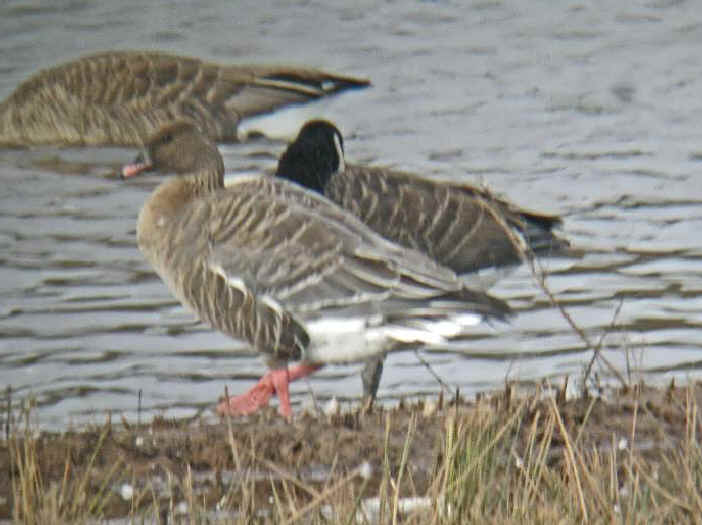
A Pink-footed Goose in Bucks County,
Pennsylvania.
Elsewhere in this website there are photos of the species in Iceland, both
adults & young.
- Lesser White-fronted Goose ______
(r/NA)
Anser erythropus
An Old World species that has recently declined in population,
especially in the western portion of its range. In North America. there is a
specimen from Attu Island, in the Aleutians, Alaska from June 5, 1994.
Outside North America, the Lesser White-fronted Goose has been seen
during FONT tours in Bulgaria, Hungary.
- Graylag Goose (ph) ______
(r/NA)
Anser anser
An Old World species that has become widely domesticated. It is a common
resident in Iceland, and it has occurred in Greenland. One landed and
remained on a ship about 120 miles southeast of St. Johns, Newfoundland from
April 24 to May 2, 2005.
Outside North America, the Greylag Goose has been seen during FONT
tours in Bulgaria, Hungary, Iceland, Japan, Poland, Spain, Sweden.
- Snow Goose (*) (ph) ______ AK:may,jun
(PI) CO:apr DE:mar,may IA:mar KS:apr NC:may NE:mar
Chen caerulescens (has been Anser caerulescens)
SUBSPECIES:
Chen caerulescens atlanticus: the
Greater Snow Goose ______
from northeast Canada and northwest Greenland to the northeastern US,
migratory
Chen caerulescens caerulescens: the
Lesser Snow Goose ______
from northeastern Siberia, northern Alaska, and northern Canada to the
United States & northern Mexico, migratory
Outside North America, the Snow Goose has been seen during FONT tours
in Iceland (where rare), Japan (where rare).
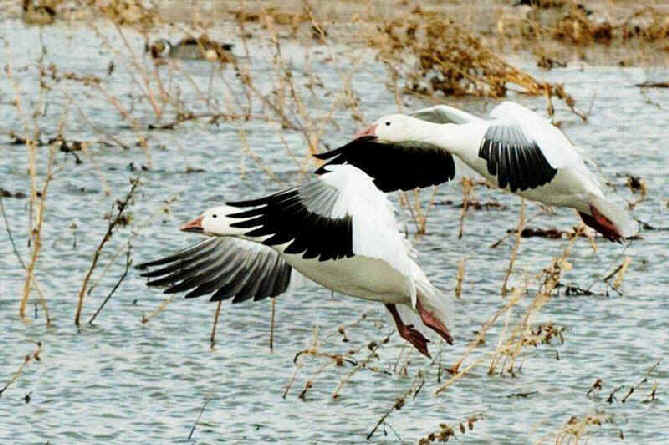
Snow Geese
(photo by Monika Dorman)
- Ross's Goose (*) ______ AK:may
(PI) AZ:jan CO:apr IA:mar NE:mar
Chen rossii (has been Anser rossii)
(monotypic)
- Emperor Goose (nt) (*) ______ AK:may,jun
Chen canagica (has been Anser canagica)
(monotypic)
- Canada Goose (*) ______ AK:may,jun
(PI) AZ:aug BC:sep CA:sep CO:apr,jul
DE:mar,apr,may IA:mar
KS:apr MD:apr NC:may,jun,jul,aug NE:mar,apr NF:jul OK:apr
VA:mar WA:sep
WY:apr
Branta canadensis
Another name could be "Greater Canada Goose", including
the larger subspecies such as B. c. parvipes.
Outside North America, the Canada Goose has been seen during FONT
tours in Sweden, where it was introduced years ago.
- Cackling Goose (ph) ______
Branta hutchinsii
Another name for Branta hutchinsii
could be "Lesser Canada Goose", including the "Aleutian
Gosse", B. h. leucopareia,
"Cackling Goose", B. h. minima,
"Taverner's Goose", B. h. taverneri.
The population of the "Aleutian Goose" of Alaska seems
to increasing, following the eradication of foxes on breeding islands.
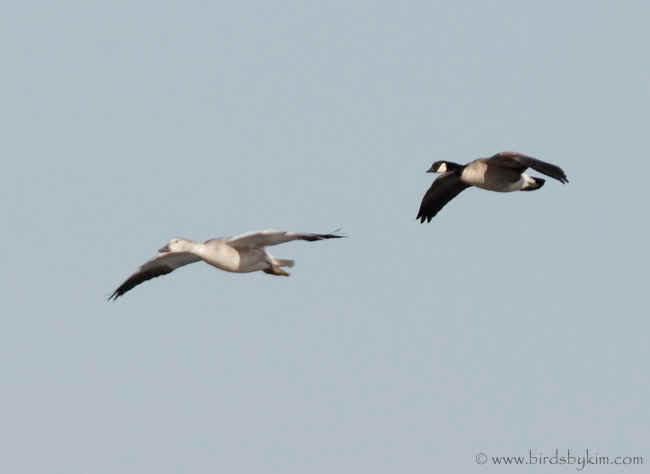
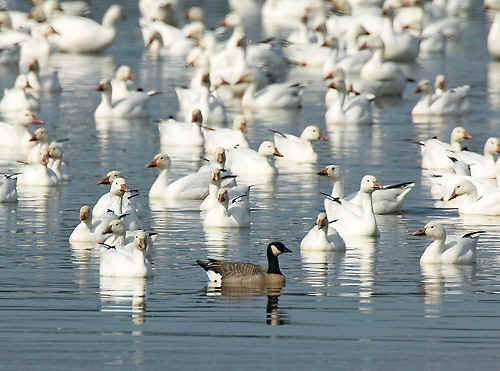
Two photographs of a Cackling Goose with Snow Geese
(photos by Kim
Steininger)
- Brant Goose (*) (ph) ______ AK:may,jun
CA:sep DE:may VA:mar WA:sep
SUBSPECIES IN NORTH AMERICA:
Branta bernicia hrota ______ subspecies from
northeast Canada and Greenland south as a migrant to the northeast US or
northwest Europe (Ireland)
Branta bernicia nigricans ______
subspecies from northeast Siberia, Alaska, and northwest Canada south
as a migrant to western North America or eastern Asia
Branta bernicia
is called Brent Goose in the Old World, and often just "Brant"
in North America.
Outside North America, the Brant has been seen during FONT tours
in Iceland, Japan, Sweden, and south of the US in Mexico (Sonora).
- Barnacle Goose (ph) ______
(r/NA)
Branta leucopsis
A species that breeds in northeast Greenland, rarely in Iceland, and
elsewhere in northern Europe. Birds that are wild occur rarely in
eastern North America.
Outside North America, the Barnacle Goose has been seen during FONT
tours in Iceland, Sweden.
- Mute Swan (i) (*) (ph) ______ CO:apr
DE:may VA:may WA:sep
Cygnus olor
Outside North America, the Mute Swan has been seen during FONT tours
in Bulgaria, Hungary, Japan, Poland, Spain, Sweden. In Europe, it is
native.
- Tundra Swan (*) ______ AK:may,jun
(ac) (PI) DE:mar NC:may VA:mar
Cygnus columbianus
SUBSPECIES IN NORTH AMERICA:
Cygnus columbianus columbianus
______
In North America, Cygnus columbianus columbianus has been
called the "Whistling Swan".
In Eurasia, Cygnus columbianus bewickii has been called the "Bewick's
Swan".
Outside North America, the "Bewick's" Tundra
Swan has been seen during FONT tours in Japan, Sweden.
- Trumpeter Swan (ph) ______ AK:may,jun
NE:apr
Cygnus buccinator (monotypic)
The Trumpeter Swan has had an interesting history. At the
beginning of the 20th Century, it was one of the rarest of North American
birds.
For information about the "Trumpeter Swan Society":
www.trumpeterswansociety.org
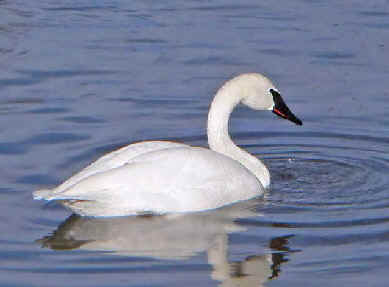
Trumpeter Swan
- Whooper Swan (ph) ______ (r/NA)
Cygnus cygnus (monotypic)
The Whooper Swan is an Old World species that occurs regularly as a winter visitor in the
western and central Aleutian Islands, Alaska. It has bred on Attu Island.
The species has rarely occurred elsewhere in northwestern North America,
south to northern California.
The Whooper Swan was described by Linnaeus in 1758.
Outside North America, the Whooper Swan has been seen during FONT
tours in Bulgaria, Iceland, Japan, Poland, Sweden.
- Common Shelduck ______ (r/NA)
Tadorna tadorna (monotypic)
An Old World species. One was in Saint John's, Newfoundland, Canada, on
November 17, 2009.
The Common Shelduck was described by Linnaeus in 1758.
Outside North America, the Common Shelduck has been seen during FONT
tours in Bulgaria, Hungary, Iceland, Poland, Spain, Sweden. Turkey.
- Muscovy Duck (ph) ______ (r/US)
Cairina moschata (monotypic)
A Neotropical species. A nest box program in northeastern Mexico helped
spread wild Muscovy Ducks into the Rio Grande Valley along the Texas-Mexico
border.
The Muscovy Duck was described by Linnaeus in 1758.
South of the US, the Muscovy Duck has been seen during FONT tours in
Argentina, Belize, Brazil, Costa Rica, Ecuador, Guatemala, Panama,
Venezuela.
- Wood Duck (*) (ph) ______
AZ:jul,aug
BC:sep CO:apr,jul DE:apr,may FL:apr IA:mar KS:apr NC:may,jun,aug NE:mar TX:apr WA:sep
Aix sponsa (monotypic)
The Wood Duck was described by Linnaeus in
1758.
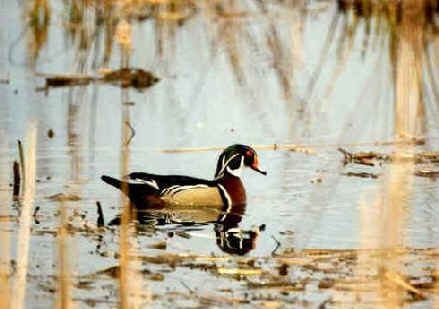
Above & below: Wood Ducks
Above: a male; below: a female with 16 young
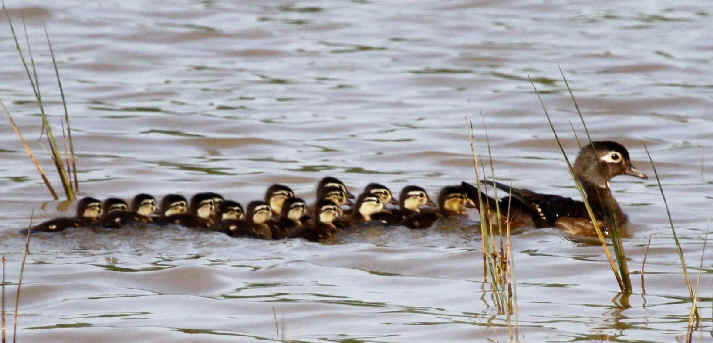
- Gadwall (*) (ph) ______ AK:jun
BC:sep CA:sep
CO:apr DE:mar,apr,may IA:mar KS:apr NC:may,jun,jul,aug NE:marapr
TX:mar,apr VA:mar WA:sep WY:apr
Anas strepera (now monotypic)
The Gadwall was described by Linnaeus in 1758.
Gadwalls were seen with young during the FONT North Carolina Tour in August
1994.
Outside North America, the Gadwall has been seen during FONT
tours in Bulgaria, Hungary, Iceland, Japan, Poland, Spain, Sweden, and
south of the US in Mexico (Sonora).
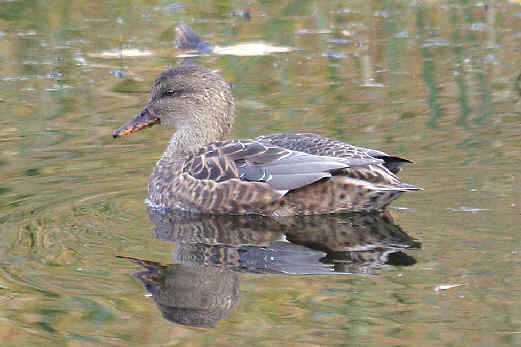
Gadwalls ABOVE: female, BELOW: male
(photos by Doris Potter)
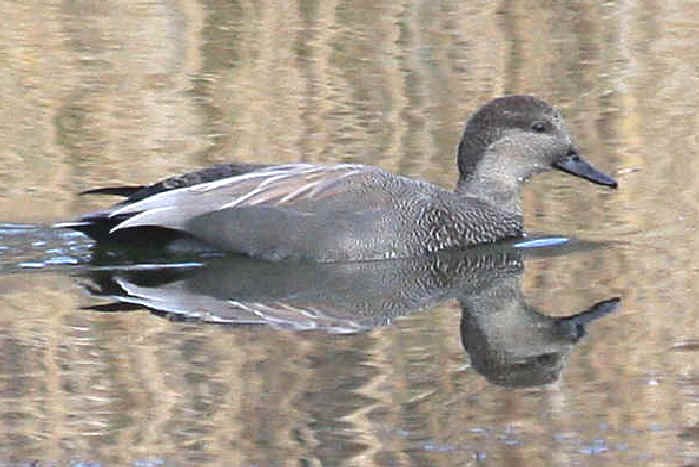
- American Wigeon (*) (ph) ______
AK:may,jun
(PI) AZ:jan,aug BC:sep CA:sep
CO:apr,jul DE:mar,apr IA:mar KS:apr NC:aug NE:mar,apr
TX:mar,apr VA:mar WA:sep WY:apr
Anas americana (monotypic)
Outside North America, the American Wigeon has been seen
during FONT tours in Japan, and south of the US in the
Dominican Republic, Guatemala, Haiti, Honduras, Jamaica, Mexico, Puerto
Rico.
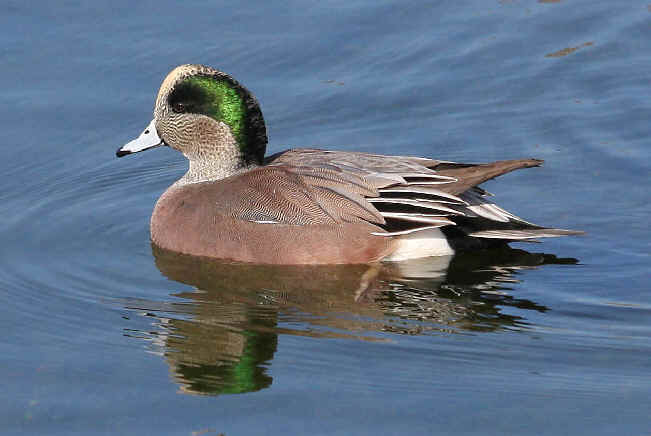
American Wigeons, a male above & a female below
(both photos by Doris Potter)
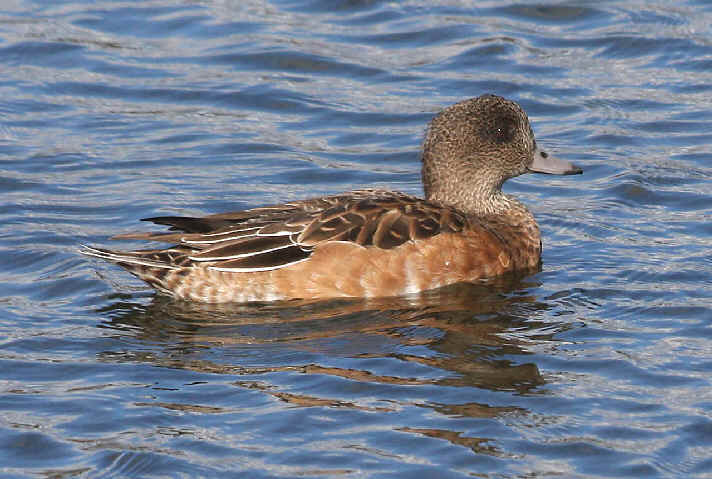
- Eurasian Wigeon (*) (ph) ______
AK:may,jun (PI) DE:mar VA:mar
Anas penelope
(monotypic)
The Eurasian Wigeon was described by Linnaeus in 1758.
Outside North America, the Eurasian Wigeon has been seen during FONT
tours in Bulgaria, Hungary, Iceland, Japan, Poland, Spain, Sweden.
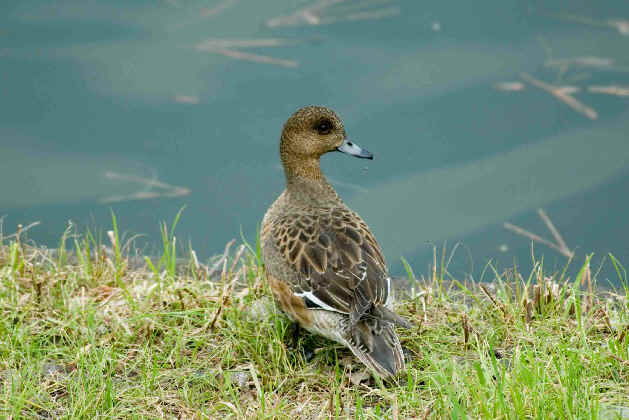
A female Eurasian Wigeon
(photo by Karl Frafjord during a FONT tour in Japan)
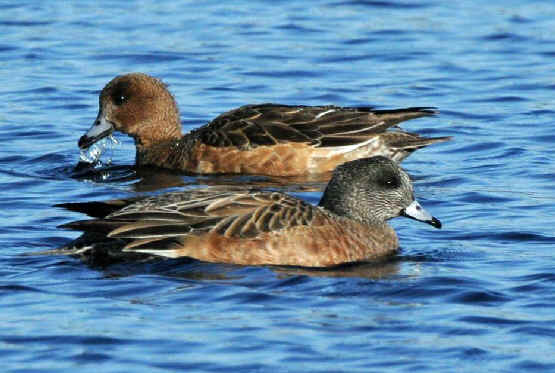
Two female Wigeons together: Eurasian
(above)
and American
(below)
(photo by Howard Eskin)
- American Black Duck (*) (ph) ______ DE:mar,apr,may
NC:may,jun,jul,aug NF:jul VA:mar
Anas rubripes (monotypic)
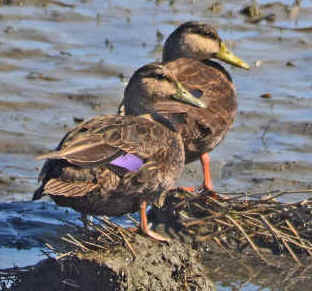
A pair of American Black Ducks
(photo by Howard Eskin)
- Mallard (*) (ph) ______ AK:may,jun
(PI) AZ:jan,jul,aug,sep BC:sep CA:sep
CO:apr,jul DE:mar,apr,may IA:mar KS:apr MD:apr
NC:may,jun,jul,aug NE:mar,apr
OK:apr TX:mar,may VA:mar WA:sep WY:apr
Anas platyrhynchos
SUBSPECIES:
Anas platyrhynchos conboschas ______ subspecies
in Greenland
Anas platyrhynchos diazi ______ has been
considered a subspecies, mostly in northern and central Mexico (SEE
BELOW, as
Mexican Duck)
Anas platyrhynchos platyrhynchos ______
widespread subspecies in much of the Northern Hemisphere
The Mallard was described by Linnaeus in 1758.
Outside North America, the Mallard has been seen during
FONT tours in Bulgaria, Hungary, Iceland, Japan, Poland, Romania,
Slovakia, Spain, Sweden, Turkey.

Above & below: Mallards
Above: male & female; below: a closer look at a female
(upper photo by Rhett Poppe; lower photo by Doris Potter)
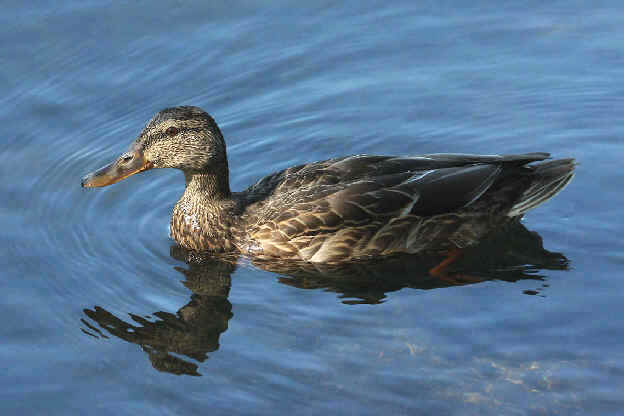
- Mexican Duck (*) ______ AZ:jul,aug,sep
TX:apr,may
(has been
considered conspecific with the Mallard)
Anas diazi
South of the US, the Mexican Duck has been seen during FONT tours
in Sonora, Mexico.
- Mottled Duck (*) ______ FL:apr
TX:mar,apr,may
Anas fulvigula
SUBSPECIES:
Anas fulvigula fulvigula ______ subspecies in
Florida
Anas fulvigula maculosa ______ subspecies in the
south-central US and northeastern Mexico
South of the US, the Mottled Duck has been seen during
FONT tours in Mexico.
- Eastern Spot-billed Duck (ph) ______
(r/US)
Anas zonorhyncha (monotypic)
An eastern Old World species that has occurred as a rarity in the
western Aleutian Islands and Kodiak island, Alaska.
Outside North America, the Eastern Spot-billed Duck has been seen
commonly during FONT tours in Japan.
- Blue-winged Teal (*) (ph) ______
AZ:aug
BC:sep CA:sep
CO:apr,jul DE:apr,may IA:mar KS:apr NC:may,aug NE:mar,apr NM:apr
OK:apr TX:mar,apr,may VA:may WA:sep WY:apr
Anas discolors (monotypic)
The Blue-winged Teal was described by Linnaeus in 1758.
South of the US, the Blue-winged Teal has been seen during
FONT tours in Belize, Cayman Islands, Costa Rica, Dominica, the
Dominican Republic, Ecuador, the Galapagos Islands, Guatemala, Haiti, Honduras, Jamaica, Mexico, Panama,
Puerto Rico, Saint Lucia, Venezuela.
- Cinnamon Teal (*) ______ AZ:jul,sep BC:sep
CA:sep CO:apr,jul WA:sep WY:apr
Anas cyanoptera
SUBSPECIES NORTH OF SOUTH AMERICA:
Anas cyanoptera septentrionalium ______
subspecies from western North America to northwest South America;
migratory, but with most in winter in the US and Mexico
South of the US, the Cinnamon Teal has been seen during
FONT tours in Argentina, Chile, Mexico.
- Northern Shoveler (*) (ph) ______
AK:may,jun
(PI) AZ:jan,aug,sep BC:sep CA:sep
CO:apr,jul DE:mar,apr,may IA:mar KS:apr NC:aug NE:mar,apr NM:apr
TX:mar,apr,may VA:mar WA:sep WY:apr
Anas clypeata (monotypic)
The Northern Shoveler was described by Linnaeus in
1758.
Outside North America, the Northern Shoveler has been seen
during FONT tours in Bulgaria, Hungary, Japan, Poland, Spain,
Sweden, Turkey, and south of the US in the Dominican Republic, Haiti,
Jamaica, Mexico.

A female Northern Shoveler
(photo by Howard Eskin)
- Northern Pintail (*) (ph) ______
AK:may,jun
(PI) AZ:jan,aug,sep BC:sep CA:sep
CO:apr,jul DE:mar,apr IA:mar KS:apr NC:aug NE:mar,apr
TX:mar,apr,may WA:sep WY:apr
Anas acita (monotypic)
The Northern Pintail was described by Linnaeus in
1758.
Outside North America, the Northern Pintail has been seen
during FONT tours in Bulgaria, Hungary, Iceland, Japan, Poland, Spain,
Sweden, and south of the US in Mexico.
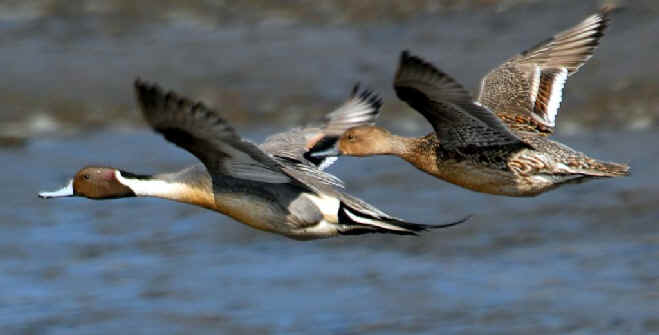
Male & female Northern Pintails in flight
(photo by Howard Eskin)
- White-cheeked Pintail (ph) ______ (r/US)
Anas bahamensis
A species with populations in some West Indian islands, including the
Bahamas, and in parts of South America. It has occurred as a vagrant in
southern Florida.
SUBSPECIES IN THE NORTHERN HEMISPHERE:
Anas bahamensis bahamensis
______ (in the Bahamas, the Greater Antilles, and northern South
America)
The White-cheeked Pintail was described by Linnaeus in 1758.
South of the US, the White-cheeked Pintail has been seen during
FONT tours in Argentina, Brazil, Chile, the Dominican Republic,
Ecuador, the Galapagos Islands, Haiti, Puerto Rico, Venezuela.
- Green-winged Teal (*) (ph) ______
AK:may,jun
(PI) AZ:jan,aug,sep BC:sep CA:sep
CO:apr,jul DE:mar,apr,may IA:mar KS:apr NE:mar,apr
TX:mar,may VA:mar WA:sep WY:apr
Anas carolinensis
The Green-winged Teal has been considered conspecific with the Eurasian
Teal (below).
Outside North America, the Green-winged Teal was seen during a
FONT tour in Iceland (a rare sighting), and south of the US during
FONT tours in Mexico.
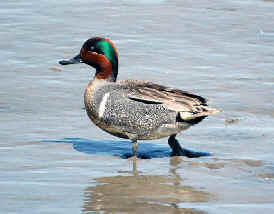
A male Green-winged Teal
(photo by Howard Eskin)
- Eurasian Teal (*) (ph) ______
AK:may,jun (PI)
Anas crecca
The Eurasian Teal was described by Linnaeus in 1758.
Outside North America, the Eurasian Teal has been seen during
FONT tours in Bulgaria, Hungary, Iceland, Japan, Poland, Spain, Sweden,
Turkey. .
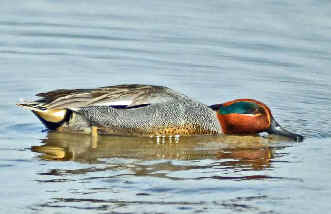
Eurasian Teal
(photo by Howard Eskin)
- Baikal Teal (t3) (ph) ______ (r/NA)
Anas formosa (monotypic)
An east Asian species, with a population that has declined in recent
decades. In North America, it has occurred as a rarity in Alaska, and even
more rarely further south along the Pacific Coast, in Washington State and
California.
Outside North America, the Baikal Teal has been seen during FONT
tours in Japan.
For more regarding the BAIKAL TEAL, go to: Rare Birds of Japan
- Falcated Duck (nt) (*) (ph) ______
(r/NA) AK:jun (PI)
Anas falcata (monotypic)
An east Asian species, that has occurred rarely in the western Aleutian
Islands and in the Pribilof Islands in Alaska, and more rarely along the
West Coast of North America.
Outside North America, the Falcated Duck has been seen during FONT
tours in Japan.
- Garganey (*) ______
(r/NA) AK:jun (PI)
Anas querquedula (monotypic)
An Old World species. It has occurred regularly, but rarely, in the
western Aleutian Islands, Alaska, and more rarely in the Pribilof Islands,
Alaska, and along the Pacific Coast and elsewhere in North America.
The Garganey was described by Linnaeus in 1758.
Outside North America, the Garganey has been seen during FONT tours
in Bulgaria, Hungary, Iceland (where rare), Japan, Poland,
Romania, Spain, Turkey.
- Common Pochard (*) (ph) ______
(r/NA) AK:may (PI)
Aythya ferina (monotypic)
An Old World species. It occurs rarely in the Pribilof Islands and in
the western & central Aleutian Islands in Alaska, and more rarely in
south coastal Alaska and south along the Pacific Coast to California.
The Common Pochard was described by Linnaeus in 1758.
Outside North America, the Common Pochard has been seen during FONT
tours in Bulgaria, Hungary, Japan, Poland, Spain, Sweden, Turkey.
- Canvasback (*) ______
AK:may,jun CO:apr,jul DE:apr NE:mar,apr WY:apr
Aythya valisineria (monotypic)
South of the US, the Canvasback has been seen during FONT tours
in Mexico.
- Redhead (*) (ph) ______ AK:may,jun
AZ:aug CA:sep
CO:apr,jul DE:apr IA:mar NE:mar,apr TX:mar,apr WA:sep WY:apr
Aythya americana (monotypic)
- Ring-necked Duck (*) (ph) ______
AK:may,jun
BC:sep CO:apr,jul DE:apr IA:mar KS:apr NE:mar,apr NM:apr WA:sep WY:apr
Aythya collaris (monotypic)
Outside North America, the Ring-necked Duck was seen during a
FONT tour in Japan, as a rarity there, and south of the US during
FONT tours in Costa Rica, Honduras, Jamaica, Mexico.

Ring-necked Duck
(photo by Howard Eskin)
- Greater Scaup (*) ______ AK:may,jun
(ac) (PI) BC:sep CO:jul IA:mar WA:sep
Aythya marila
SUBSPECIES IN NORTH AMERICA:
Aythya marila mariloides ______ (subspecies in
northeastern Asia and northern & western Canada to mostly the US,
migratory)
The Greater Scaup was described by Linnaeus in 1761.
Outside North America, the Greater Scaup has been seen during
FONT tours in Bulgaria, Hungary, Iceland, Japan, Romania, Sweden.
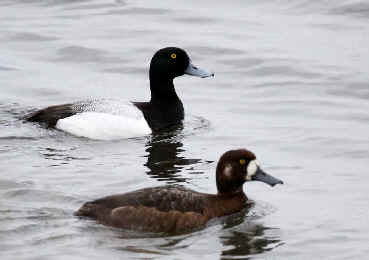
A pair of Greater Scaup photographed during a
FONT tour
(photo by Marie Gardner)
- Lesser Scaup (*) (ph) ______
AK:may,jun
AZ:jan,jul,sep CA:sep
CO:apr,jul IA:mar KS:apr NE:mar,apr TX:mar WA:sep WY:apr
Aythya affinis (monotypic)
South of the US, the Lesser Scaup has been seen during
FONT tours in the Dominican Republic, Haiti, Jamaica, Mexico, Puerto
Rico.
- Tufted Duck (*) (ph) ______
(r/NA) AK:jun (PI)
Aythya fuligula
(monotypic)
The Tufted Duck is an Old World species. In North America, it is a regular visitor in
western Alaska, and has occurred as a winter visitor along the East Coast as
far south as Maryland, and along the West Coast south to California. It has
occurred elsewhere in North America, including rarely in the Great Lakes
area.
The Tufted Duck was described by Linnaeus in 1758.
Outside North America, the Tufted Duck has been seen during FONT
tours in Bulgaria, Hungary, Iceland, Japan, Poland, Spain, Sweden.
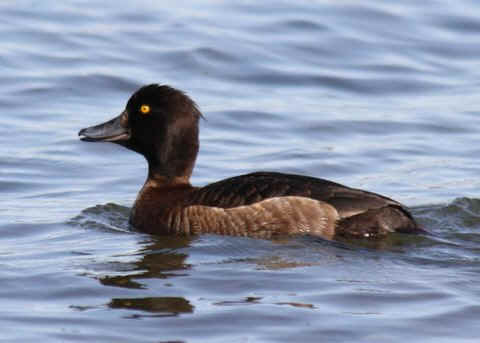
A female Tufted Duck photographed during a FONT
tour
(photo by Gabi Hauser)
- Harlequin Duck (*) (ph) ______ AK:may,jun
(PI) BC:sep CA:sep DE:mar WA:sep
Histrionicus histrionicus (monot6ypic)
The Harlequin Duck was described by Linnaeus in 1758.
Outside North America, the Harlequin Duck has been seen
during FONT tours in Iceland, Japan.
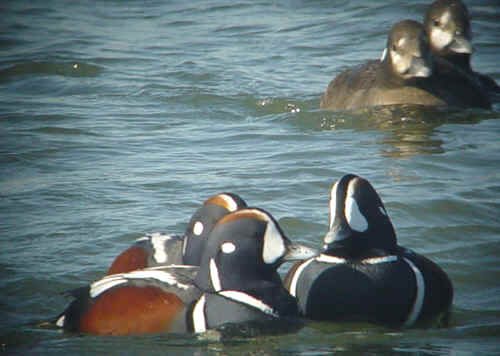
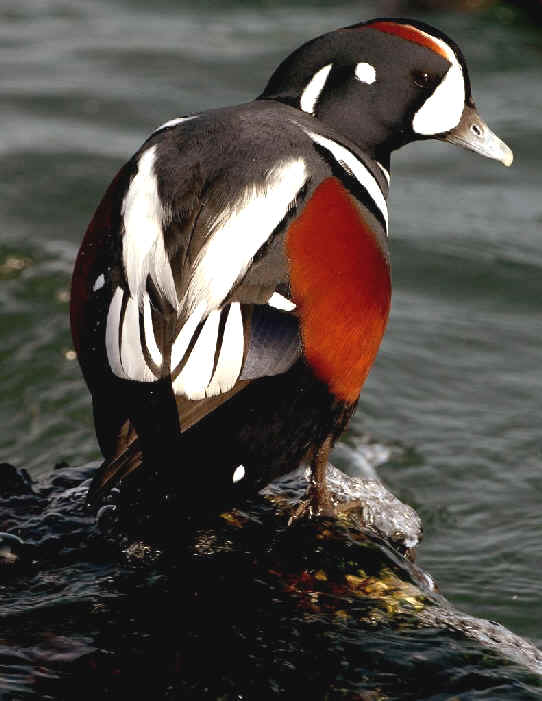
Above & below: Harlequin Ducks
A group of males and females in top photo; a male in the middle photo, and
a raft of Harlequins below.
(photos by Howard Eskin and Andy Bernick)
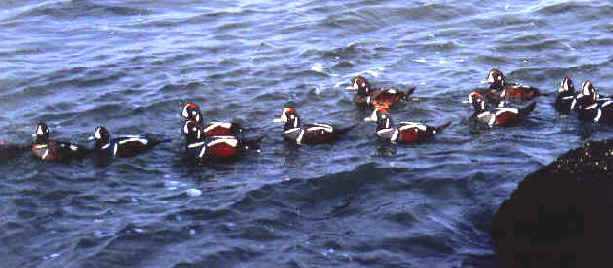
- Common Eider (*) (ph) ______
AK:may,jun
(PI) NC:aug
Somateria mollissima
SUBSPECIES IN NORTH AMERICA:
Somateria mollissima borealis ______ subspecies
in northeastern Canada, Greenland, Iceland to the North Atlantic, partly
migratory
Somateria mollissima dresseri ______ subspecies
in southeastern Canada and the northeastern US to the Atlantic coast,
partly migratory
Somateria mollissima sedentaria ______
subspecies in the area of the Hudson Bay, described in 1943
Somateria mollissima v-nigra ______ subspecies
in Alaska and northeastern Asia to the Bering Sea and the Aleutian
islands, migratory
The Common Eider was described by Linnaeus in 1758.
A Common Eider was first in the surf, and then resting on the sand, at Cape Hatteras during the FONT North
Carolina Tour in August 1993.
Outside North America, the Common Eider has been seen during FONT
tours in Iceland, Sweden.
In Iceland, there are many.

Above & below: Common Eiders
Above: a female; below: a male in breeding plumage
(lower photo by Howard Eskin)
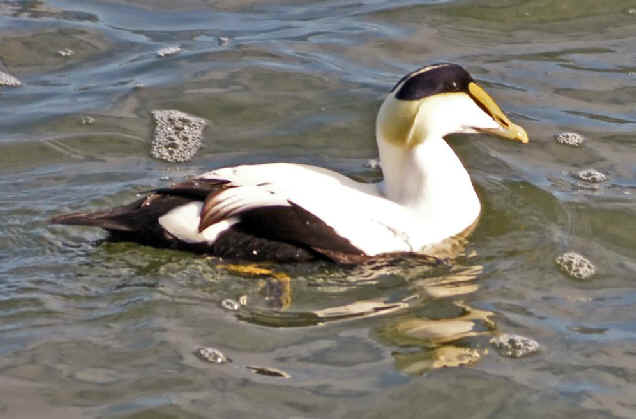
- King Eider (*) (ph) ______
AK:may,jun (PI)
Somateria spectabilis (monotypic)
The King Eider was described by Linnaeus in 1758.
Outside North America, the King Eider has been seen during FONT
tours in Iceland, where it is rare.
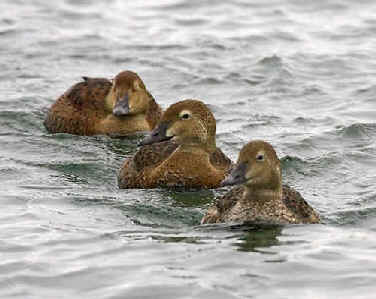
Above & below: King Eiders
Above: females; below: an immature male, and below that, an adult male,
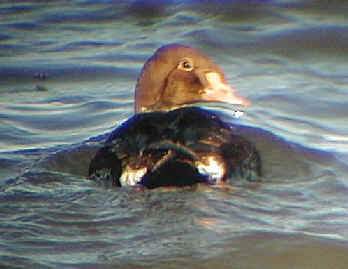
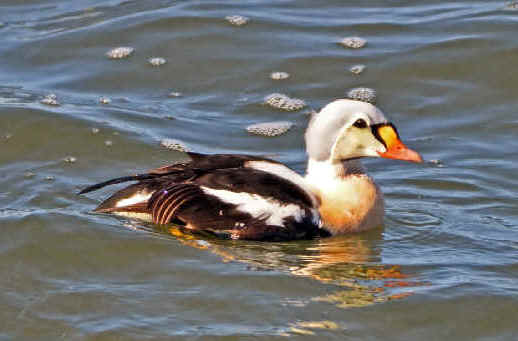
- Spectacled Eider (t3) (*) ______
AK:may,jun
Somateria fischeri
(monotypic)
Spectacled Eiders
form large wintering flocks in the Bering Sea. From aerial surveys in
the 1990s, the average estimate of the number of birds in those flocks was
over 300,000.
- Steller's Eider (t3) (*) (ph) ______
AK:may,jun
(PI)
Polysticta stelleri (monotypic)
Outside North America, the Steller's Eider has been seen during a
FONT tour in Sweden, where it was a rarity.
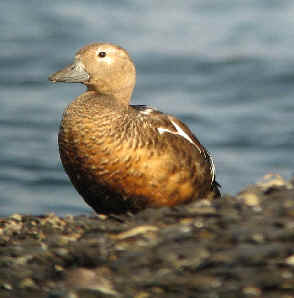
A female Steller's Eider
(photo Claude Bloch during a FONT tour in Sweden)
- Surf Scoter (*) (ph) ______
AK:jun
(PI) BC:sep CA:sep DE:mar NJP:dec WA:sep
Melanitta perspicillata (monotypic)
The Surf Scoter was described by Linnaeus in 1758.
South of the US, the Surf Scoter has been seen during
FONT tours in Mexico (Sonora).
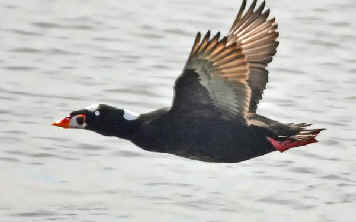
Above: an adult male Surf Scoter in flight
Below: a first-winter Surf Scoter
(photos by Howard Eskin)
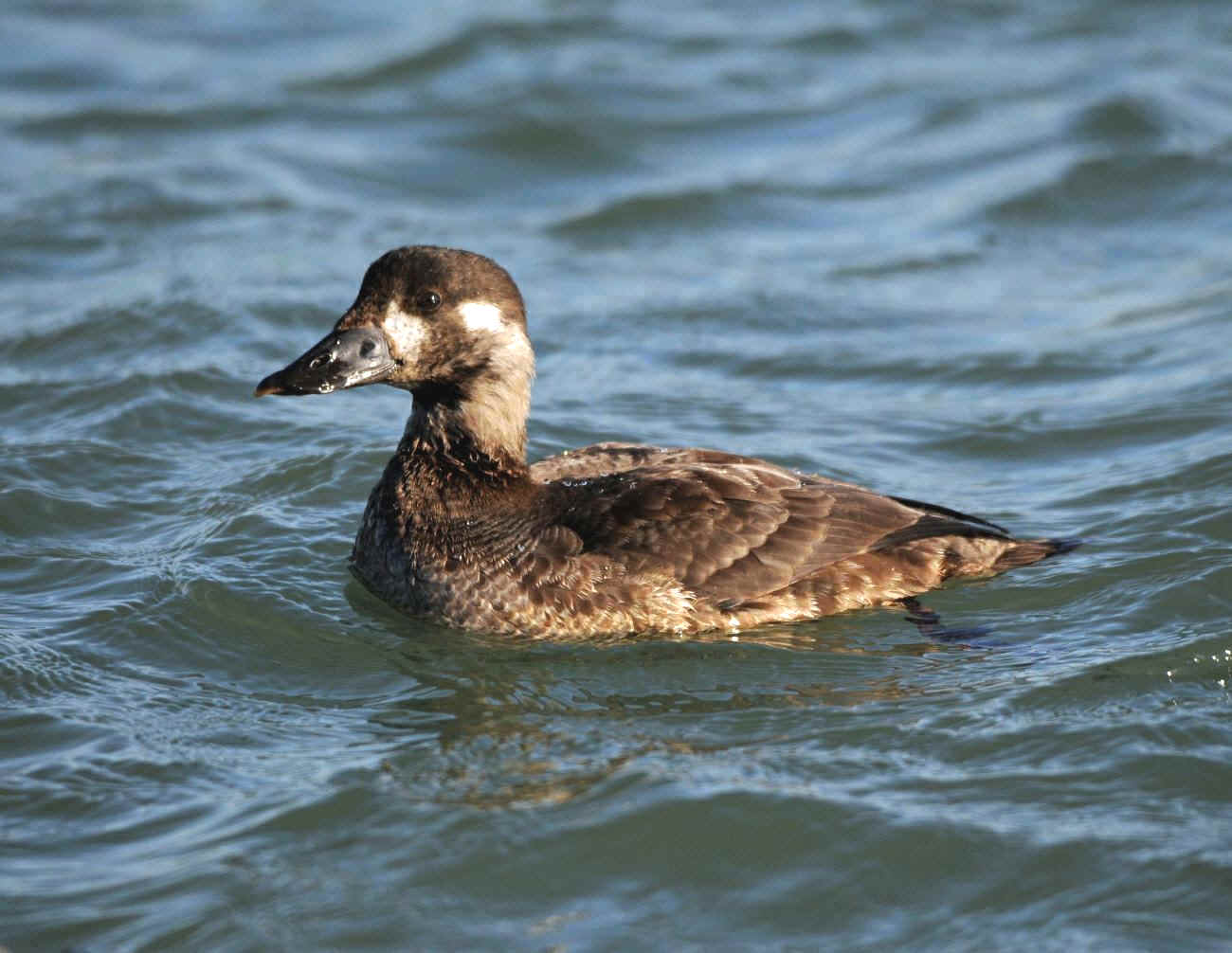
- White-winged Scoter (*) ______
AK:may,jun
(PI) BC:sep DE:may NJP:dec TX:mar WA:sep
Melanitta deglandi
Outside North America, what has been the White-winged Scoter has been
seen during FONT tours in Japan, when the population was M. d.
stejnegeri, "Stejneger's Scoter".
The White-winged Scoter was conspecific with the Velvet Scoter, Melanitta
fusca, of Europe. It also has been conspecific with what is
now said to be the Asian White-winged Scoter, Melanitta
stejnegeri.
- Black Scoter (*) (ph) ______
AK:may,jun
BC:sep DE:may NC:may WA:sep
Melanitta americana (monotypic)
Outside North America, the Black Scoter has been seen
during FONT tours in Japan.
The Black Scoter was conspecific with the Common Scoter, Melanitta
nigra, of Europe.



















































